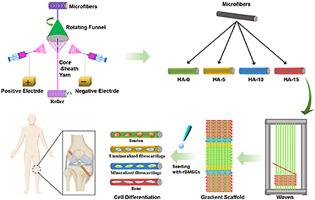Composites Part B: Engineering ( IF 12.7 ) Pub Date : 2021-02-07 , DOI: 10.1016/j.compositesb.2021.108679 Xianrui Xie , Jiangyu Cai , Yiling Yao , Yujie Chen , Atta ur Rehman Khan , Jinglei Wu , Xiumei Mo

|
Healing of the tendon-to-bone interface remains a challenge in clinical practice due to its unique gradient structure. Despite substantial efforts to reproducing the transitional structure from mineralized to nonmineralized tissue, successful regeneration of tendon-to-bone interface through tissue engineering approaches remains rare. To maximally simulate the four distinct zones of the tendon-to-bone interface, a novel three-dimensional (3D) hydroxyapatite (HA) gradient scaffold with spatial mineral distribution is implemented through a combined strategy of electrospinning and traditional textile manufacturing. Our results showed that the scaffold allows sustained release of Ca ions from each segment in a gradient manner. Besides, this scaffold is structurally anisotropic with excellent mechanical properties. In vitro study demonstrated that the mineralized segments boosted the proliferation of mouse embryo osteoblast precursor cells (MC3T3-E1) cells and promoted osteogenic differentiation of rat bone marrow stem cells (rBMSCs), while nonmineralized segment improved the tenocytes differentiation of rBMSCs. Moreover, the HA gradient scaffold was able to spatially guide the differentiation of rBMSCs, leading to the formation of neotissue with structural, biochemical, and biomechanical characteristics similar to that of the tendon-bone insertion site. Overall, this study introduces an approach to inducing targeted and localized stem cell differentiation for tissue engineering applications, and the HA gradient scaffold holds enormous potential for tendon-to-bone tissue regeneration.
中文翻译:

具有连续矿物梯度的编织支架,用于腱到骨组织工程
由于其独特的梯度结构,腱-骨界面的愈合在临床实践中仍然是一个挑战。尽管为从矿化组织转变为非矿化组织的过渡结构做出了巨大努力,但通过组织工程学方法成功地再生肌腱到骨的界面仍然很少。为了最大程度地模拟肌腱-骨界面的四个不同区域,通过电纺和传统纺织制造相结合的策略,实现了具有空间矿物分布的新型三维(3D)羟基磷灰石(HA)梯度支架。我们的结果表明,该支架可以使Ca离子以梯度方式从每个片段持续释放。此外,该支架是结构各向异性的,具有优异的机械性能。体外研究表明,矿化片段促进了小鼠胚胎成骨前体细胞(MC3T3-E1)的增殖,并促进了大鼠骨髓干细胞(rBMSCs)的成骨分化,而非矿化片段则改善了rBMSC的肌腱细胞分化。此外,HA梯度支架能够在空间上指导rBMSCs的分化,从而导致新组织的形成,其结构,生化和生物力学特性与腱-骨插入位点相似。总的来说,这项研究引入了一种诱导针对组织工程应用的靶向和局部干细胞分化的方法,并且HA梯度支架具有从肌腱到骨组织再生的巨大潜力。











































 京公网安备 11010802027423号
京公网安备 11010802027423号